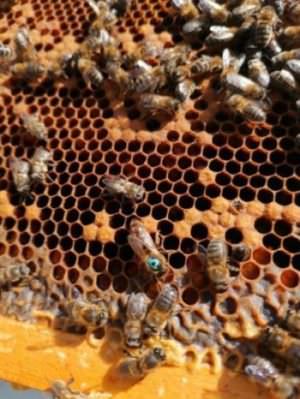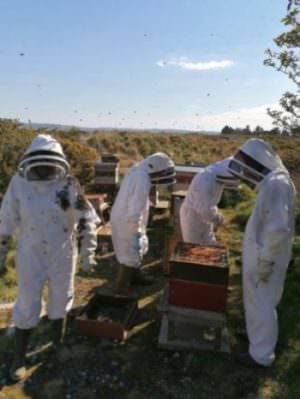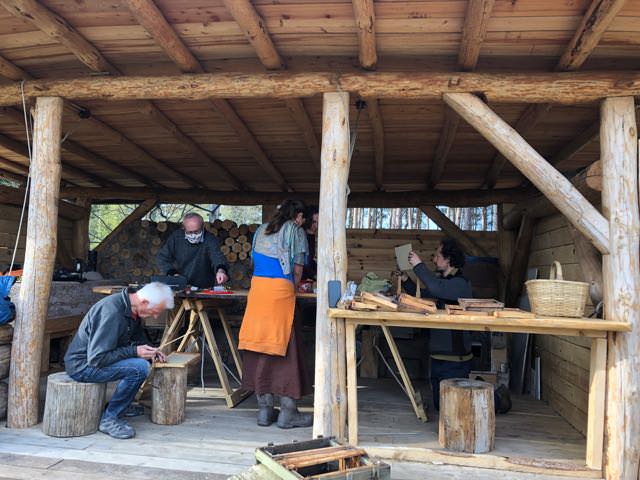 I live at the Findhorn Apiary with my sisters and cousins. About 100,000 of us lived through last winter, in eight hives and were delighted that all eight colonies were healthy and ready for spring.
I live at the Findhorn Apiary with my sisters and cousins. About 100,000 of us lived through last winter, in eight hives and were delighted that all eight colonies were healthy and ready for spring.
In the autumn we had been given plenty of lovely thick sugar syrup to fill our combs, so we had a full larder to keep us fed through the cold months. We were also given packs of sugar fondant just in case we got hungry. The treatment given against the varroa mite, which sucks fluids out of our bodies and spreads viruses to us, was very effective, so it gives us a good start to the season.
The people who come to help us are very attentive to our needs. They call themselves beekeepers but really it is us, and our sisters worldwide, who sustain them by fertilising many of their food crops.
This spring our beekeepers decided to give us some extra syrup with a seaweed extract. We really loved it and soon our queens increased their rate of laying, ready for the first flow of nectar. Unfortunately, the weather has been so cold the nectar has been delayed so it has been hard work for us feeding all our youngsters.
Most of the young bees are female but we have made some larger cells in which the queen lays unfertilised eggs. These develop into drones, male bees. They wander around trying to look busy, waiting for us to feed them. They have large eyes so when a young queen goes off for her mating flight they can easily see and follow her. I think that is all the drones are interested in!
On one of our foraging trips around the gardens at The Park we came across a tub of water with seaweed in it. It was delicious, and we had learnt that it was good for us, soon lots of us were making special trips to drink there.
 Our beekeepers come and visit us every week. There are more of them this year and the new ones are keen to learn all about us. It is funny listening to the ‘experienced’ beekeepers talking about us. They know quite a lot but we often give them a surprise by doing something unexpected. Perhaps they should spend more time listening to us.
Our beekeepers come and visit us every week. There are more of them this year and the new ones are keen to learn all about us. It is funny listening to the ‘experienced’ beekeepers talking about us. They know quite a lot but we often give them a surprise by doing something unexpected. Perhaps they should spend more time listening to us.
They have tried a double queen system on two hives, where the upper brood box is partitioned off from the lower one, so another queen is raised in it. In time there should be lots of bees ready to forage during the main nectar flow. We wait to see if this works.
Our beekeepers are very keen that we do not swarm. We like to do this. Some of us can go off and set up a new colony in a new home. That is our natural way of increasing our population. However, our beekeepers have various arrangements to ensure that our new home is in their apiary. It is a bit disruptive to our way of life but with all the problems we face in the wild, we are more likely to survive by being kept in the apiary.
We heard that some people have been very kind, giving funds to help provide us with what we need. Robert Holden has again given a donation. NFD also gave to us in exchange for some tree work that John Willoner had done for them. Thank you.
Some of our foragers spotted a team of our beekeepers working at the Outdoor Learning Space. They were busy making new frames of foundation on which we can build new comb. They talked a lot about us, they seem to really enjoy being a beekeeping team and are happy for more people to come to learn about us.


















A bee’s view of life at the Findhorn Apiary
In the autumn we had been given plenty of lovely thick sugar syrup to fill our combs, so we had a full larder to keep us fed through the cold months. We were also given packs of sugar fondant just in case we got hungry. The treatment given against the varroa mite, which sucks fluids out of our bodies and spreads viruses to us, was very effective, so it gives us a good start to the season.
The people who come to help us are very attentive to our needs. They call themselves beekeepers but really it is us, and our sisters worldwide, who sustain them by fertilising many of their food crops.
This spring our beekeepers decided to give us some extra syrup with a seaweed extract. We really loved it and soon our queens increased their rate of laying, ready for the first flow of nectar. Unfortunately, the weather has been so cold the nectar has been delayed so it has been hard work for us feeding all our youngsters.
Most of the young bees are female but we have made some larger cells in which the queen lays unfertilised eggs. These develop into drones, male bees. They wander around trying to look busy, waiting for us to feed them. They have large eyes so when a young queen goes off for her mating flight they can easily see and follow her. I think that is all the drones are interested in!
On one of our foraging trips around the gardens at The Park we came across a tub of water with seaweed in it. It was delicious, and we had learnt that it was good for us, soon lots of us were making special trips to drink there.
They have tried a double queen system on two hives, where the upper brood box is partitioned off from the lower one, so another queen is raised in it. In time there should be lots of bees ready to forage during the main nectar flow. We wait to see if this works.
Our beekeepers are very keen that we do not swarm. We like to do this. Some of us can go off and set up a new colony in a new home. That is our natural way of increasing our population. However, our beekeepers have various arrangements to ensure that our new home is in their apiary. It is a bit disruptive to our way of life but with all the problems we face in the wild, we are more likely to survive by being kept in the apiary.
We heard that some people have been very kind, giving funds to help provide us with what we need. Robert Holden has again given a donation. NFD also gave to us in exchange for some tree work that John Willoner had done for them. Thank you.
Some of our foragers spotted a team of our beekeepers working at the Outdoor Learning Space. They were busy making new frames of foundation on which we can build new comb. They talked a lot about us, they seem to really enjoy being a beekeeping team and are happy for more people to come to learn about us.